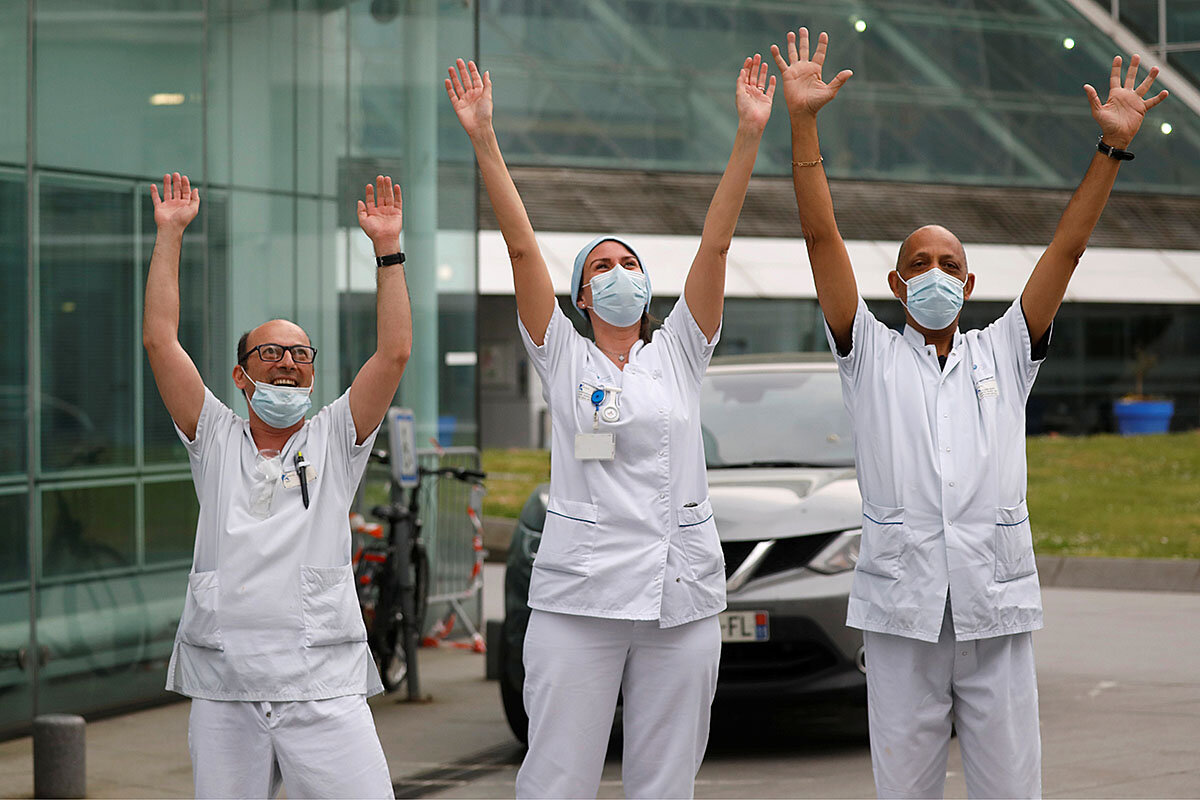Coronavirus response puts EU solidarity to the test
Loading...
| Berlin; and Basel, Switzerland
The coronavirus crisis hit Spain so fast and hard that within days every ward at the Hospital HM Torrelodones near Madrid was taken over by COVID-19 patients. Single rooms were doubled up until the beds ran out. The quantity and quality of protective gear available to medical staff diminished as days gave way to nights and the cases – and death toll – mounted. Help never came from neighboring countries.
“There is no teamwork,” says Adriana Vinasco, who works as an auxiliary nurse at the hospital. “Each country took decisions on their own and in their own timing.”
The coronavirus crisis revived familiar fault lines within the eurozone, with the public health crisis hitting southern countries earlier and harder. An economic recovery will cost an estimated 10% of the European Union’s GDP, or $1.7 trillion, estimates the EU’s industry chief Thierry Beton. But it is unclear who will pay that bill, whether it will be carried only by the countries most in need, such as Italy and Spain, or if the pain will be spread across the EU to include the more financially fit Germany, Austria, and the Netherlands.
Why We Wrote This
European nations responded to the coronavirus largely on their own. But many next steps will require coming together, and that will be a test of how unified Europe can be.
Editor’s note: As a public service, all our coronavirus coverage is free. No paywall.
Margaritis Schinas, the EU’s “European Way of Life” commissioner, sees this as no surprise. Given the unprecedented nature and intensity of the crisis, member states initially tried to organize as best they could – although not always in a coordinated way. Now they have entered what he characterizes as a “convergence phase”: gravitating toward common solutions as the EU responds to the public health crisis while also figuring out how to mitigate its economic impact.
“There is no doubt that our way of life has been greatly affected, but the values that underpin our way of life remain always intact,” he said during an online event organized by the Center for European Analysis. “Member states found out very clearly that they have more in common than they would think – not only the market, but also the interdependence of our economies, the values, the principles, the mobility that shapes our societies in Europe.”
Hard-hit economies and health systems
The economic devastation is intense in Italy, Spain, and France, where death tolls have been high and economic shutdowns persist. Small businesses have been hit particularly hard, says Heloise de Castelnau, a Paris intellectual property and business lawyer. She is working overtime to help her clients apply for government aid so they can pay landlords, workers, and suppliers. “But the system is complicated,” she says, “and it’s about postponing taxes and extending loans but someday we will have to pay the bills. Right now it’s an emergency plan.”
COVID-19 relief programs offered in France have been uneven. For example, self-employed individuals can access new forms of aid, but the amount is based on sales, which makes it hard for startups or businesses with little to no sales to qualify. Refugee entrepreneurs face additional hurdles; they don’t have the in-country credit history required to qualify for loan guarantee programs, says FAIRE, a Paris-based endowment fund for refugees.
For now, most French are looking to their own government for rescue. “The EU feels really far away,” she says. “Maybe in May, we’ll have more perspective on things.”
In Italy, the public health system suffers from under-investment, with a spending cut of €37 billion ($40 billion) over the past decade, according to the Gimbe Foundation. Now the pandemic has overwhelmed hospital systems and killed more than 25,000 people. It will need reform. “We are at risk of paying the bill of decades of cost-cutting,” says Quirino Piacevoli, who headed up the intensive care unit at a major hospital in Rome for 20 years.
What’s the ideal outcome?
The preferred solution divides cleanly along northern and southern European lines, much as it did following the global financial crisis of 2008. Then, lifelines were offered to hard-hit countries across the eurozone, but lending came with conditions largely set by wealthy countries such as Germany and the Netherlands.
People in the south felt the conditions intervened deeply in their internal affairs, says Anke Hassel, a public policy professor at Berlin’s Hertie School. For example, Greece was required to cut its minimum wage and make drastic spending cuts to get its economic house in order.
“It felt deeply unfair, and the experience of that time left very bad feelings, in particular, among southern European countries – Italy, Spain, Greece, and to some extent Portugal,” says Dr. Hassel.
Here we are 10 years later, she says, facing a similar situation. “Southern European countries are hit harder, and they don’t have the money to pay for fiscal stimuli or for their businesses to survive the crisis. They’re really facing much more hardship.”
Italy and Spain demand “coronabonds,” which would spread the borrowing risk across the European Union. France’s Emmanuel Macron also supports joint debt, saying the future of the European project is at stake.
However, leaders of Germany, the Netherlands, and Austria are inclined to say no. Germany, the EU’s economic powerhouse, has so far weathered COVID-19 with relatively low death tolls, and is slowly starting to reopen its economy. It’s carried budget surpluses and has kept its economy afloat with massive spending packages.
Instead, what eurozone finance ministers have so far agreed upon is a €500 billion package of emergency relief measures. “The Eurogroup last week did not close many doors,” says Francesco Nicoli, assistant professor in economics and international governance at the University of Ghent in Belgium. “It forged a short-term agreement but the real crux, the real problem is if and what to do with this recovery fund.”
Still ahead are important decisions about how to structure – and who will pay for – the very expensive economic reconstruction efforts required after the coronavirus subsides.
A make or break moment
European leaders on both sides of the divide recognize this as a make or break moment for Europe. German Chancellor Angela Merkel has called the crisis the “biggest test” the EU has faced since its foundation, while Italian Prime Minister Giuseppe Conte goes all the way back to World War II for a greater trial.
Dr. Nicoli argues that any agreement which leaves hard-hit countries with the impression that they have been shortchanged risks empowering euroskeptic parties. In Italy, the right-wing League already boasts mass appeal, and Italians across the political spectrum are quick to express feelings of abandonment. They’re troubled that help was quicker to come from countries such as China and Cuba than from within the EU.
“The European Union has not proven to be a real union,” says Vanessa Ferreri, a pediatric nurse at the intensive care unit and neonatal pathology at the Gaslini Hospital in Genoa, Italy. “If there are countries in difficulty, they do not allow each other to sink but they support each other. These difficulties did not stem from a political error, but from a health emergency.”
EU Commission President Ursula von der Leyen recently apologized to Italy. She said it is “true that too many were not there on time when Italy needed a helping hand at the very beginning. For that, it is right that Europe as a whole offers a heartfelt apology.”
It will take time
Mr. Schinas, the EU commissioner, says the pandemic exposed an asymmetry between what people expect from the EU and the bloc’s actual competencies. How schools and hospitals are organized in a time of crisis is the prerogative of each state, however, many still turned to the EU for guidance on how to react to the pandemic.
Because Italy faced the worst of the crisis first, it provided valuable lessons for countries in the north, which helped them dampen the pandemic’s impact, notes Dr. Nicoli.
It may take a while, but he believes countries will eventually come together, as they did through the creation of the European Stability Mechanism a few years after the 2008 financial crisis or in the wake of the 2015 migration crisis. “It is a different type of crisis,” he says. “Politics [moves] much faster nowadays. This time it might take up to one year.”
Dr. Hassel, the public policy professor in Berlin, says that it’s very difficult for “both sides” of the EU argument to accept each other’s model. But “it would be really sad if Italy ends up thinking it’s all Germany’s fault.”
Editor’s note: As a public service, all our coronavirus coverage is free. No paywall.







